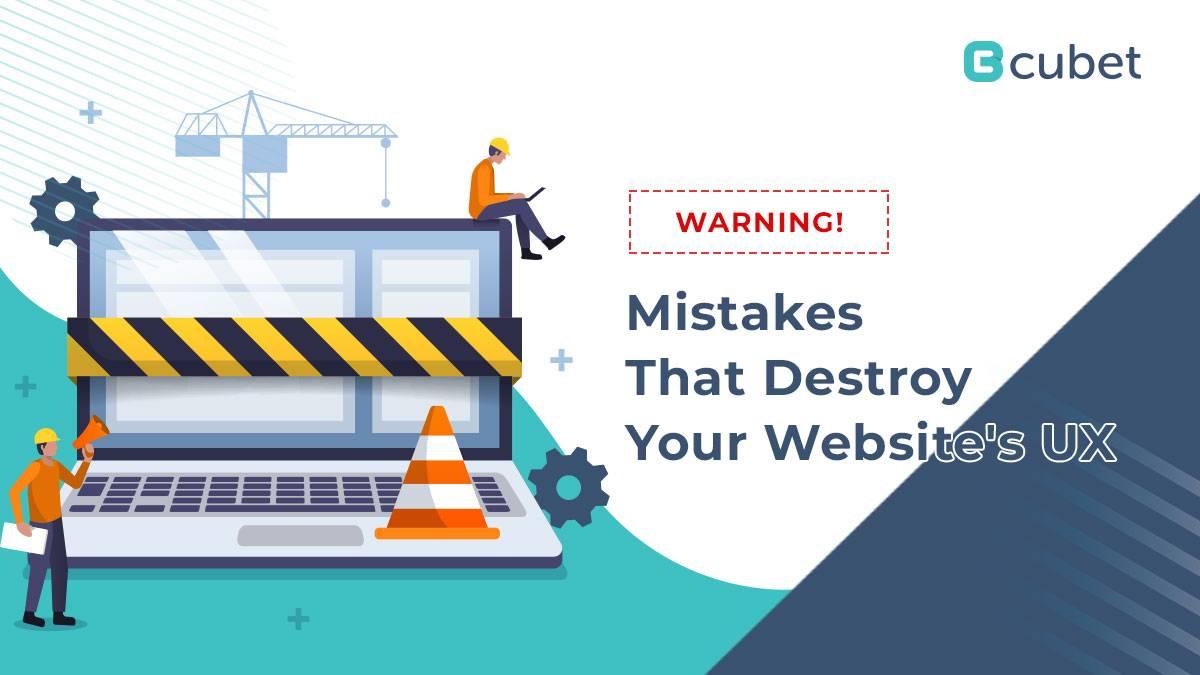Warning! These Mistakes Will Destroy Your Website’s User Experience

Setting up a website may be simple, but your real task begins once you complete the setup. You will need to update your site content, work on the structure, and optimize it for SEO and User experience.
Most people ignore the UX part and pay attention to aesthetics, but the user experience is the main aspect of your site. A poor user experience can tarnish your website’s reputation and affect your conversion rate.
Besides, to achieve a higher return on investment, it’s essential to work on exceptional design, result-oriented marketing strategies, and of course, valuable content.
Do not let UX ruin your website and online presence. Let’s dive deep and look at SEO mistakes that can put your site in jeopardy.
Mistakes that Will Destroy Your Website’s User Experience:
1. Non-performance of website
If your website is not performing well, it will cost you dearly in the long run. A non-performing website can derail the user experience, and search engine Google can penalize you. Following this, it is essential to audit your site every three to four months to check the vulnerabilities.
Clear up your site and make the experience easy to use for the site visitors. Additionally, check for site issues or broken links. If you find broken links, fix them immediately.
Always be willing to change your site’s look and update the old content. Search algorithms are not fond of old websites, do remember that.
2. Careless use of background images
A web development company may use a full background image for your site. Agreed, a high-quality image on your site’s background will leave a wonderful impact.
But this can be a mistake on the UX part. High-quality images or other images must complement the website. Even an image site should be careful in selecting the background images.
Plus, big fonts and bright backgrounds may not always look good. The function of an image is to blend with the site aesthetic in the best possible way. Your site’s focus must be on other elements – apart from the images. Besides, don’t ignore the CTA part behind attention-grabbing images.
3. Cluttered layout and content
A website with a cluttered layout and content is the biggest turn-off for the site visitor. Creativity has its place, but not at the cost of making your site look like a piece of art, and if the message is unreached, what’s the point in creating the site?
Your site should not distract the visitors with a cluttered layout or content. Besides, if the design fails to differentiate between the information, the users may leave your site.
New site visitors may be overwhelmed looking at so many site distractions therefore, it is essential to use modern design standards and white space. A clean layout can improve the UX of the site.
4. Slow loading
Slow loading is the main aspect of the user experience. If your site takes a long time to load, users will abandon your site. Plus, slow loading pages can destroy the flow of the website. It also has an impact on the Search engine optimization of the site.
A one-second delay in loading can cause more than a 15% decrease in customer satisfaction. As a site owner, you need to pay special attention to the page loading feature.
Start by optimizing the site images and avoid using too many plugins on the site. In addition, you can optimize CSS delivery and minimize HTTPS requests. Minify the resources and reduce site redirects.
5. Non-monitoring of activities on site
Apart from regular audits, it is vital to monitor your site. You will need to monitor your site’s performance every month to check on on-site errors and issues. Besides, track how new users engage with your site. Get an insight into your site performance.
You can use the Google analytics tool to monitor your site performance and how to improve the working of the site. Besides, if the user spends little time on your page, ensure that the time increases and they spend more time so that it increases your conversion rate. With the site monitoring feature, you’ll know about customer engagement.
6. Not optimizing it for SEO
Search engine optimization is a critical aspect of your site. If you don’t optimize your site for SEO – you won’t get the right reach. However, SEO optimization is significant for the UX of the site. Every time you create new content, it needs to be optimized for SEO, so your site gets a good rank in SERP.
Plus, this also helps to boost the visibility of the content you create. Additionally, you can add internal links to your site to boost visibility and references. Add links to all the previous posts you have created as it will leave a good impact.
7. Not optimizing for mobile
Google now considers mobile-first indexing, which means you need to create websites that are responsive and mobile-friendly. Plus, mobile-friendly websites have a higher chance of ranking on SERP.
It has a direct impact on how users view your web page. A mobile version of the website is easy to read, and most users browse the web through smartphones today. Create a mobile-friendly website to improve the UX, so that users don’t navigate from the page. Additionally, building a mobile-friendly website helps in SEO optimization.
Conclusion
The above mistakes can affect your site’s user experience. So, don’t wait for these mistakes to ruin your site, and work on them to manage your site. Brand awareness and site visibility matter in the web space and a proper UX design and structure can leave a great impact on users.
Develop short-term goals and strategies that can help to improve your site’s UX. When your website is your passion, you need to ensure everything works seamlessly. It may require effort and time, but the results will be great.